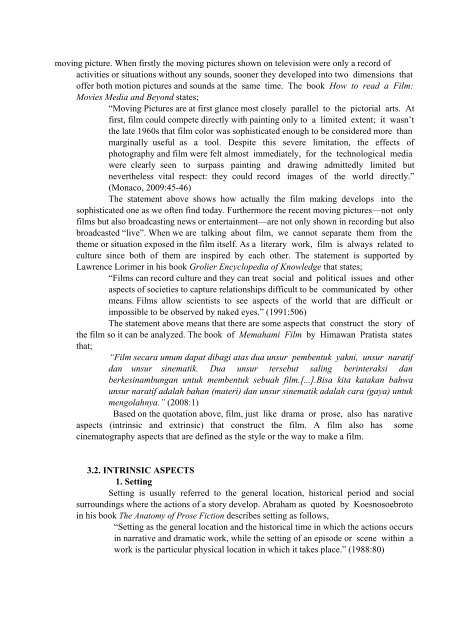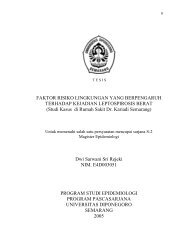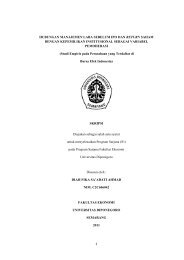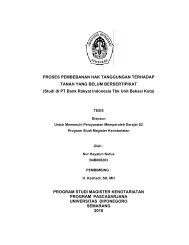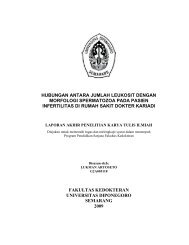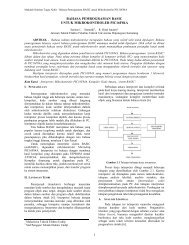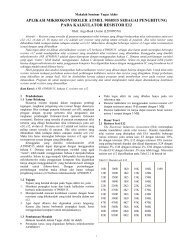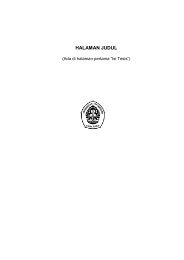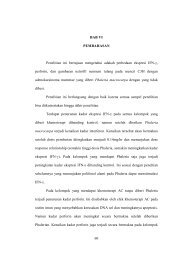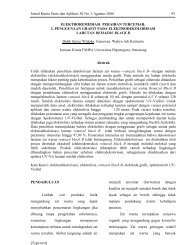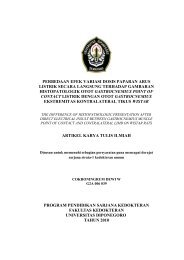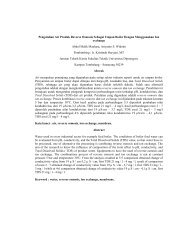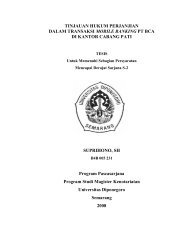THE SPIRIT OF FEMINISM REFLECTED IN THE MAIN ... - Undip
THE SPIRIT OF FEMINISM REFLECTED IN THE MAIN ... - Undip
THE SPIRIT OF FEMINISM REFLECTED IN THE MAIN ... - Undip
You also want an ePaper? Increase the reach of your titles
YUMPU automatically turns print PDFs into web optimized ePapers that Google loves.
moving picture. When firstly the moving pictures shown on television were only a record of<br />
activities or situations without any sounds, sooner they developed into two dimensions that<br />
offer both motion pictures and sounds at the same time. The book How to read a Film:<br />
Movies Media and Beyond states;<br />
“Moving Pictures are at first glance most closely parallel to the pictorial arts. At<br />
first, film could compete directly with painting only to a limited extent; it wasn’t<br />
the late 1960s that film color was sophisticated enough to be considered more than<br />
marginally useful as a tool. Despite this severe limitation, the effects of<br />
photography and film were felt almost immediately, for the technological media<br />
were clearly seen to surpass painting and drawing admittedly limited but<br />
nevertheless vital respect: they could record images of the world directly.”<br />
(Monaco, 2009:45-46)<br />
The statement above shows how actually the film making develops into the<br />
sophisticated one as we often find today. Furthermore the recent moving pictures—not only<br />
films but also broadcasting news or entertainment—are not only shown in recording but also<br />
broadcasted “live”. When we are talking about film, we cannot separate them from the<br />
theme or situation exposed in the film itself. As a literary work, film is always related to<br />
culture since both of them are inspired by each other. The statement is supported by<br />
Lawrence Lorimer in his book Grolier Encyclopedia of Knowledge that states;<br />
“Films can record culture and they can treat social and political issues and other<br />
aspects of societies to capture relationships difficult to be communicated by other<br />
means. Films allow scientists to see aspects of the world that are difficult or<br />
impossible to be observed by naked eyes.” (1991:506)<br />
The statement above means that there are some aspects that construct the story of<br />
the film so it can be analyzed. The book of Memahami Film by Himawan Pratista states<br />
that;<br />
“Film secara umum dapat dibagi atas dua unsur pembentuk yakni, unsur naratif<br />
dan unsur sinematik. Dua unsur tersebut saling berinteraksi dan<br />
berkesinambungan untuk membentuk sebuah film.[...].Bisa kita katakan bahwa<br />
unsur naratif adalah bahan (materi) dan unsur sinematik adalah cara (gaya) untuk<br />
mengolahnya.” (2008:1)<br />
Based on the quotation above, film, just like drama or prose, also has narative<br />
aspects (intrinsic and extrinsic) that construct the film. A film also has some<br />
cinematography aspects that are defined as the style or the way to make a film.<br />
3.2. <strong>IN</strong>TR<strong>IN</strong>SIC ASPECTS<br />
1. Setting<br />
Setting is usually referred to the general location, historical period and social<br />
surroundings where the actions of a story develop. Abraham as quoted by Koesnosoebroto<br />
in his book The Anatomy of Prose Fiction describes setting as follows,<br />
“Setting as the general location and the historical time in which the actions occurs<br />
in narrative and dramatic work, while the setting of an episode or scene within a<br />
work is the particular physical location in which it takes place.” (1988:80)


